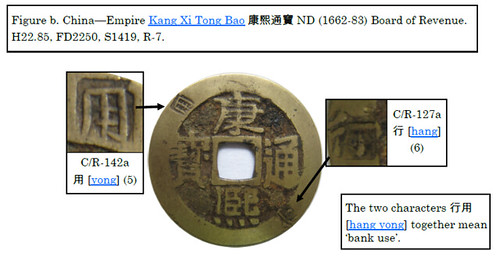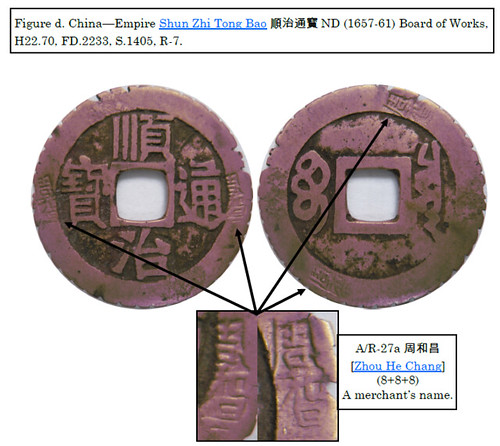
PREV ARTICLE
NEXT ARTICLE
FULL ISSUE
PREV FULL ISSUE
CHOPPED CHINESE COPPER CAST COINSOne article I found especally interesting in the March 2017 issue of Chopmark News was Cedric Cheung's "Observations on Chinese Chopmarked Copper Coins"
(p27-36), where he discusses chopped copper cast coins. Like Cedric, I was puzzled by why anyone would go to the trouble of marking such a low-value coin with no intrinsic metal value. With
permission, here's an excerpt. -Editor
 My interest in chopmarked Chinese cast coins was an accident. I started out collecting American silver dollars and it wasn’t too long until I discovered chopped US trade dollars. This opened up the fascinating world of chopmarked world silver coin collecting. After I moved to China for work, I started a type set collection of Chinese cast coins which spans al-most 2000 years of Chinese numismatic history (a very ambitious undertaking!). To my surprise, I soon noticed there were an abundance of chopped copper cast coins being offered in Chinese coin stores and auction web sites. It seemed only natural to combine my interest in chopmarks and Chinese cast coins together. I hope the following description of a selection of chopmarked coins from my collection will be of interest to the CCC community. The first question to answer is why would the Chinese even chopmark these low value cop-per coins at all? Almost all examples of the host coins were of the lowest denomination cast coins, so unlike silver crowns, they would be hardly worth the shroffs’ time to check for authenticity. I have no first hand sources, but dealers and collectors from the two largest coin auction and discussion websites believe that in the past many kinds of businesses wanted to provide tokens or alternative currency for their customers, and the easiest way to do that was to use existing circulating coins and chop them. Most businesses such as money exchangers and prototype banks (錢莊), however, simply chopped cast coins for their customers’ transactions. Similarly, other kinds of businesses chopped coins to be used as a sort of token for customers to spend. Some businesses or individuals even chopped their own names on these coins to be given to customers as a sort of “name card” or advertisement. American and British businesses of the 19th century had the identical practice of countermarking US large cents and British pennies for advertisement and making tokens.  The variety of chopmarks are quite similar to ones found on silver coins consisting of incuse and relief types made up mostly of Chinese characters, symbols, and edge cuts. However, there are relatively more Chinese proper names and auspicious phrases on cast than on silver coins. Indeed the price that dealers quote seems to increase the more auspicious the phrase. Incidentally, I have never come across a cast coin with an ink chop. Chopmarks were usually struck on the outer rim of the coin and rarely in the field. Oftentimes a single chopmark would be repeated in a symmetrical pattern. Interestingly, wholly unlike silver coins, these coins are never found with different chopmarks from multiple businesses except for one exception.... Lastly, chopped cast coins can be found in coin stores in China, Hong Kong, and Taiwan, but are most easily found on Chinese coin auction websites. Unlike chopped silver coins which are sold at a discount and considered damaged, cast coins with chops are actually highly prized by Chinese collectors and may be three to five times more expensive than regular non-chopped coins. It is my hope that after reading this article, there may be more collectors outside of China who also appreciate these unique and fascinating coins. Until reading Cedric's article I was unaware of chopmarks on cast Chinese coins. As a longtime collector of tokens and merchant counterstamps, the explanation of their use rings
true, and I can understand why these are more highly prized by collectors in China. These are great opportunities for collecting and research. -Editor
For more information about the Chopmark Collectors Club, see:
 Wayne Homren, Editor The Numismatic Bibliomania Society is a non-profit organization promoting numismatic literature. See our web site at coinbooks.org. To submit items for publication in The E-Sylum, write to the Editor at this address: whomren@gmail.com To subscribe go to: https://my.binhost.com/lists/listinfo/esylum All Rights Reserved. NBS Home Page Contact the NBS webmaster 
|